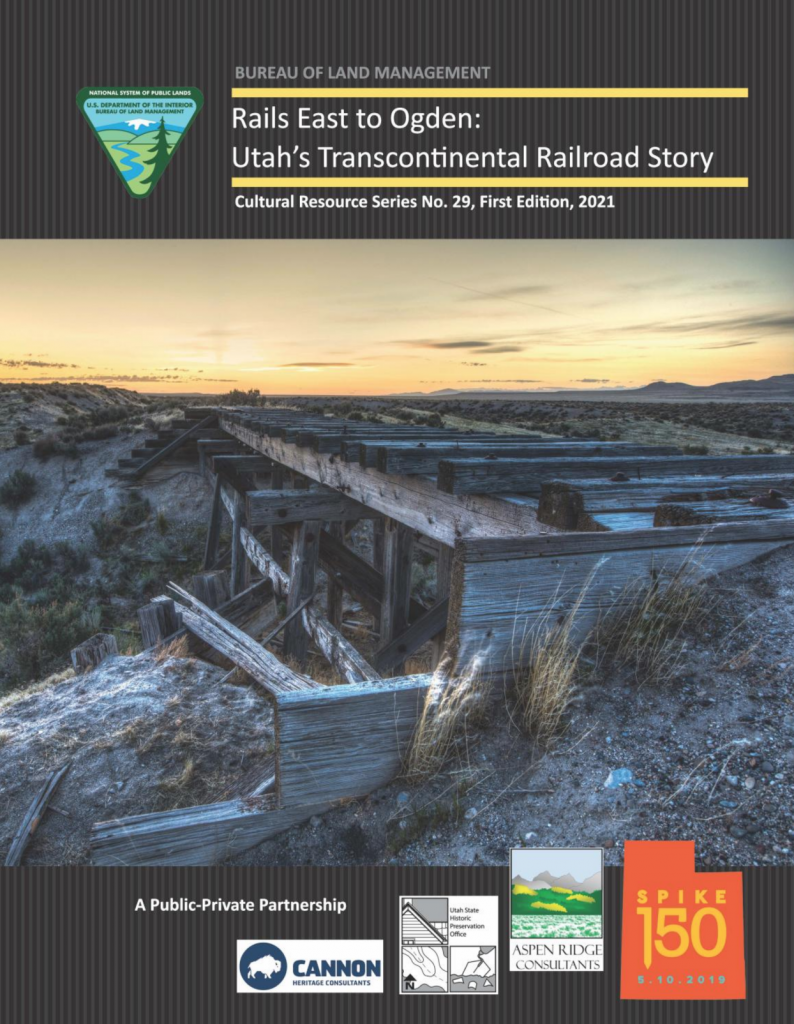Date: 07.12.2021 (Season 3, Episode 8; 1:20 minutes). Click here for the BuzzSprout version of this Speak Your Piece Episode. The cropped image above is taken from a map entitled, “The Promontory Branch of the First Transcontinental Railroad in Utah, 1869 – 1904,” published in 1981 and republished in 1994, BLM Utah Cultural Resources Series #8 Rails East to Promontory, the Utah Stations by Anan S. Raymond and Richard E. Fike. Courtesy of US Bureau of Land Management. Note: The original railroad line above the lake, completed in 1869, and cutting through the middle of the lake, the time and resource cutting Lucin Cut-Off, which was completed in 1904. Are you interested in other episodes of Speak Your Piece? Click here for more episodes.
Podcast Content:
What can be encountered on one of the United State’s most austere and vacant landscapes? A whole lot, including a largely “unknown national treasure,” an eighty-seven mile stretch of raised railroad grade, built across a breathtaking scenic and cultural landscape, winding around the Great Salt Lake, with views of the Promontory, Hansen, Hogup, Grouse Creek, Newfoundland and Lakeside Mountains. On this road you will experience a landscape largely as travelers would have experienced it circa 1869 to 1900. There is nothing like it among the surviving segments of the 1862-1869 transcontinental railroad.
Speaking of their 2021 publication, Rails East to Ogden: Utah’s Transcontinental Railroad Story (a BLM Utah, Cultural Series Publication) historical archaeologists Michael Polk (Aspen Ridge Consultants) and Christopher W. Merritt (Utah SHPO) interpreted over ten years of new research and discoveries. They offer fascinating descriptions concerning Chinese immigrant work camps and life (including later more substantial China towns). Garbage strewn about and buried, documenting immigrant goods and containers that traveled from such places as China, Ireland and Europe; ghost towns where once hundreds of people lived in bunk houses, pleasure gardens, hotels, bakeries and even a public library; water lines made of hollowed redwood logs which once quenched thirsty steam locomotives; a half a dozen railroad facilities (now only rubble); and adjoining stagecoach roads that took people and goods to frontier Idaho and Montana; all adjacent to a railroad grade that was actively used from 1869 to 1942.
Podcast Episode:
Traveling northward from Ogden into Box Elder County, then west to Corrine (State Road 13), then on to Golden Spike National Historical Park (State Road 83 and the Golden Spike Road), then traveling largely on the railroad bed to Kelton and Terrace, and onward to the state-line (after Corrine all the towns are ghost towns) you will be traveling on the BLM Scenic Transcontinental Backcountry Byway. If you want to take this trip, plan to go from mid summer to early fall; however you may sit back and experience this landscape with your ears via this discussion with Messrs. Polk and Merritt.
The episode includes stories (and the evidence) about the artifacts and ruins that, after being scientifically and archaeologically examined, challenge us to reassess what we know about Utah’s earliest railroad and the state’s very ethnically diverse past.
It is acknowledged that the extended landscapes described in this episode are ancestral lands of the Shoshone people, among other adjacent tribes.
Topics Discussed in Time:
- Minute: 00:00 – 09:45 Host Brad Westwood introduces archaeologist Michael Polk and State Historic Preservation officer Christopher W. Merritt, both of whom have published the study, Rails East to Ogden: Utah’s Transcontinental Railroad Story for the Bureau of Land Management. This publication was possible through a grant received from the National Park Service in 2015 to document underrepresented populations. Michael Sheehan, Kenneth P. Cannon, and Molly Boeka Cannon were essential contributors to the research and the writing of this book.
- Minute: 09:45 – 16:15 Historical archaeology is the discipline of studying the past while also examining physical artifacts and documents. Artifacts tell a story that may not be told by self-conscious humans; it verifies or contradicts by using science, which biased records (books, manuscripts, photographs, etc.) often do not tell. Science has set itself into the historical production with the purpose of authenticating or discrediting history. Polk and Merritt practiced historical archaeology in order to document and produce more accurate, cohesive and comprehensive stories.
- Minute: 16:15 – 27:08 Broken bottles and ceramics are a few of the remains left behind on the transcontinental railroad, they are tangible connections to the past. We now see these connections to people of the past, leaving these artifacts untouched demonstrates respect for the people that came before us. From an archaeological science perspective, the analyzing of artifact placements give context and content to the reconstruction of stories such as the story of the Chinese railroad workers who had little written about them. Rails East to Ogden: Utah’s Transcontinental Railroad Story adds new scholarship and research from the last forty years.
- Minute: 27:08 – 37:30 Spatial segregation by ethnicity and nationality existed during the construction of the transcontinental railroad. These practices were not written into code but enforced by behaviors and an understanding between Anglo community members and railroad contractors. Polk conducted a comprehensive site inventory of the Golden Spike National Historical Park, something that had not been done before. He found over twenty labor or construction sites including bunk houses, stores, roundhouses and more. Much of Polk and Merritt’s analysis was informed by the survey of hundreds of facilities that documented ethnic segregation of the work populations. Contributions made by Chinese immigrant workers on the transcontinental railroad were not properly documented due to the minimal interaction between Anglos and the Chinese despite the fact that some of them worked on the railroad for 50 years.
- Minute: 37:30– 45:42 The efforts to build the Transcontinental Railroad across the Great Salt Lake were abandoned. Towns in Box Elder County, Utah were vibrant communities, populated by people and businesses in contrast to their present-day ghost town appearance. Guests share the companies involved and the reasons why the project never saw its completion.
- Minute: 45:42 – 58:50 War and famine in China influenced many Chinese men to search other parts of the world for labor opportunities and an escape from the Chinese government. While Union Pacific wanted to hire white labor, the allure of the gold fever created an inconsistent and undependable labor force. Chinese workers were dependable since they worked collectively and communally. This segment discusses the Chinese Exclusion Act (1882) and the unreliable US Census records, efforts that did not include minority and immigrant populations. Stanford’s Chinese Railroad Workers of North America Program helped support and give insight to Polk and Merritt’s publication and work.
- Minute: 1:00:00 – 1:20:00 Through the lens of historical archaeology, Polk and Merritt describe the function of the towns Blue Creek, Corrinne, Promontory and Terrace during the 1860s. Polk and Merritt read newspaper excerpts (provided by the Utah Digital Newspaper Project) to give more context of the social infrastructure of these towns. They both hope that the public can recognize how much progress has been made in society by the way we talk about other groups. By publishing their research through BLM they wish to make their work accessible to the public.

Bio: Michael Polk is a historical archaeologist for the Western United States. He is the principal and owner of Aspen Ridge Consultants, a heritage resources firm providing consultation in historical archaeology, history and architectural history. Polk has a long career in archaeology, serving in companies such as Sagebrush Consultants and Environment Consultants. He has been investigating Utah’s diverse cultural and industrial landscapes for over forty years.

Bio: Christopher W. Merritt is a historical archaeologist and the Utah State Historic Preservation Officer (SHPO), based out of the Utah Division of State History. Merritt is a leading advocate for historical archaeology throughout the western United States. He is the author of numerous studies, reports and academic articles, and is the author of the book The Coming Man from Canton: Chinese Experience in Montana, 1862 – 1943 (2017).

Additional Resources & Readings:
To read Michael Polk’s and Chris Merritt’s 2021 BLM publication Rails East to Ogden: Utah’s Transcontinental Railroad Story there is free version on the electronic publishing platform Issuu.

After our July 2021 interview with Polk and Merritt, a team of archaeologists and volunteers led by Merritt, conducted an archaeological dig of a burned and buried Chinese building in Terrace, Utah. A archaeological first, across the entire 1,776 miles of the transcontinental railroad grade. To learn more about this discovery, read the Smithsonian Magazine article Artifacts Used by Chinese Transcontinental Railroad Workers Found in Utah and Live Science’s article Chinese Railroad Worker house unearthed in Utah ghost town

Before planning a trip to this Back-country Byway, read “How to Visit Rock Imagery Sites Like an Archaeologist,” by Utah’s Public Archaeologist Elizabeth Hora. See and read also Tread Lightly! Respect & Protect website (an awareness campaign to eliminate looting and vandalism of archaeological and paleontological resources).

See Chinese Railroad Workers of North America Program website. This Stanford University project includes research efforts in both North America and China, offering new scholarship and insights concerning the19th century Chinese experience in America.

Visit the Golden Spike National Historical Park, celebrating and documenting one of the greatest technological achievements of the 19th century. Visitors can see the Last Spike site, walk or drive the original railroad grades for both the Central Pacific and Union Pacific Railways (including a series of deep cuts and fills), and get an up close look at two mid-19th century replica locomotives.
Do you have a question or comment, or a proposed guest for “Speak Your Piece?” Write us at “ask a historian” – [email protected]


